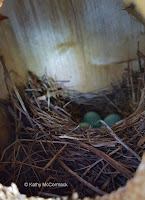EASTERN BLUEBIRD
EASTERN BLUEBIRD – (Sialia sialis) – (See images below)
DESCRIPTION: The Eastern Bluebird male has blue top parts and an orange breast. The underside is white. The bill and eyes are black, and the legs are grey. Females are a washed out version of the male. Juveniles are mottled brown on top with blue wings and tail. This bird is about 20 cm (8 inches) long.
VOICE: https://www.xeno-canto.org/species/Sialia-sialis
NAME: The Latin name refers to an unidentified bird.
HABITAT: Open spaces such as fields, parks, golf courses. Birds often seen perched on wires or posts.
DIET: Insects (sometimes caught on the fly) and berries for the most part.
NESTING: Bluebirds nest in cavities (tree holes or nest boxes) and they will aggressively compete with other males of their species, and other species as well, to claim a coveted spot. About two to six light blue eggs are laid, incubated by the female. Chicks are fed by both parents.
DISTRIBUTION: Breeding range covers southeast Canada from Saskatchewan, and the northeast part of the USA. It is a year-round resident in the remainder southeast part of the USA, and mid-regions of Mexico. Wintering populations are found along the eastern half border USA-Mexico.
DISTRIBUTION MAP: https://en.wikipedia.org/wiki/Eastern_bluebird#/media/File:Sialia_sialis_distribution.png
ON PEI: Although observed only rarely or occasionally, the eastern bluebird breeds on Prince Edward Island (see photos below).
CONSERVATION: Several decades ago bluebird numbers were in decline, mainly due to competition for nesting areas from introduced species such as the European Starling and the House Sparrow. Due to the threat of extinction, volunteers started building nest boxes for them in the 1950s, along ‘Bluebird Trails’ all across North America. (But the first bluebird nest boxes were actually built in the 1800s by concerned bird lovers.)
Those trails are rows of wooden nest boxes on top of fence posts in fields, spaced about 200 meters and located in accessible areas for maintenance. The openings of those boxes are made small enough to keep the European starling out. This bird’s numbers have increased since then. There are now several ‘bluebird societies’ in Canada and the USA, for the conservation and protection of this bird.
NOTES: The eastern bluebird is part of the same family as the American Robin (Thrushes) and share sthe same breast color, dark orange, although it is smaller.
The bluebird has a long history in association with human beings and there’s even a special word for work associated with this bird: bluebirding. Because of their diet, they are sought after by farmers and gardeners to rid their crops of pests. The bluebird is also celebrated in various songs.
The eastern bluebird is the State Bird of Missouri.
SIMILAR SPECIES: Indigo Bunting (female)
REFERENCES: https://www.borealbirds.org/bird/eastern-bluebird
https://www.mba-aom.ca/jsp/toc.jsp (Maritimes Breeding Bird Atlas)
https://www.allaboutbirds.org/guide/Eastern_Bluebird/id
https://www.thespruce.com/eastern-bluebird-387244
https://en.wikipedia.org/wiki/Eastern_bluebird
https://www.audubon.org/field-guide/bird/eastern-bluebird
American Bird Conservancy (Eastern Bluebird)
https://nature.mdc.mo.gov/discover-nature/field-guide/eastern-bluebird (Missouri Department of Conservation)
DESCRIPTION: The Eastern Bluebird male has blue top parts and an orange breast. The underside is white. The bill and eyes are black, and the legs are grey. Females are a washed out version of the male. Juveniles are mottled brown on top with blue wings and tail. This bird is about 20 cm (8 inches) long.
VOICE: https://www.xeno-canto.org/species/Sialia-sialis
NAME: The Latin name refers to an unidentified bird.
HABITAT: Open spaces such as fields, parks, golf courses. Birds often seen perched on wires or posts.
DIET: Insects (sometimes caught on the fly) and berries for the most part.
NESTING: Bluebirds nest in cavities (tree holes or nest boxes) and they will aggressively compete with other males of their species, and other species as well, to claim a coveted spot. About two to six light blue eggs are laid, incubated by the female. Chicks are fed by both parents.
DISTRIBUTION: Breeding range covers southeast Canada from Saskatchewan, and the northeast part of the USA. It is a year-round resident in the remainder southeast part of the USA, and mid-regions of Mexico. Wintering populations are found along the eastern half border USA-Mexico.
DISTRIBUTION MAP: https://en.wikipedia.org/wiki/Eastern_bluebird#/media/File:Sialia_sialis_distribution.png
ON PEI: Although observed only rarely or occasionally, the eastern bluebird breeds on Prince Edward Island (see photos below).
CONSERVATION: Several decades ago bluebird numbers were in decline, mainly due to competition for nesting areas from introduced species such as the European Starling and the House Sparrow. Due to the threat of extinction, volunteers started building nest boxes for them in the 1950s, along ‘Bluebird Trails’ all across North America. (But the first bluebird nest boxes were actually built in the 1800s by concerned bird lovers.)
Those trails are rows of wooden nest boxes on top of fence posts in fields, spaced about 200 meters and located in accessible areas for maintenance. The openings of those boxes are made small enough to keep the European starling out. This bird’s numbers have increased since then. There are now several ‘bluebird societies’ in Canada and the USA, for the conservation and protection of this bird.
NOTES: The eastern bluebird is part of the same family as the American Robin (Thrushes) and share sthe same breast color, dark orange, although it is smaller.
The bluebird has a long history in association with human beings and there’s even a special word for work associated with this bird: bluebirding. Because of their diet, they are sought after by farmers and gardeners to rid their crops of pests. The bluebird is also celebrated in various songs.
The eastern bluebird is the State Bird of Missouri.
SIMILAR SPECIES: Indigo Bunting (female)
REFERENCES: https://www.borealbirds.org/bird/eastern-bluebird
https://www.mba-aom.ca/jsp/toc.jsp (Maritimes Breeding Bird Atlas)
https://www.allaboutbirds.org/guide/Eastern_Bluebird/id
https://www.thespruce.com/eastern-bluebird-387244
https://en.wikipedia.org/wiki/Eastern_bluebird
https://www.audubon.org/field-guide/bird/eastern-bluebird
American Bird Conservancy (Eastern Bluebird)
https://nature.mdc.mo.gov/discover-nature/field-guide/eastern-bluebird (Missouri Department of Conservation)
 |
| Eastern bluebird male, by Lynne Bradley |
 |
| Eastern bluebird male, Lynne Bradley |
 |
| Eastern bluebird female, Lynne Bradley |
 |
| Eastern bluebird eggs in nest box, by Kathy McCormack |
 |
| Eastern bluebird chicks in nest box, by Kathy McCormack |
 |
| Eastern bluebird pair on nest box, Kmac |